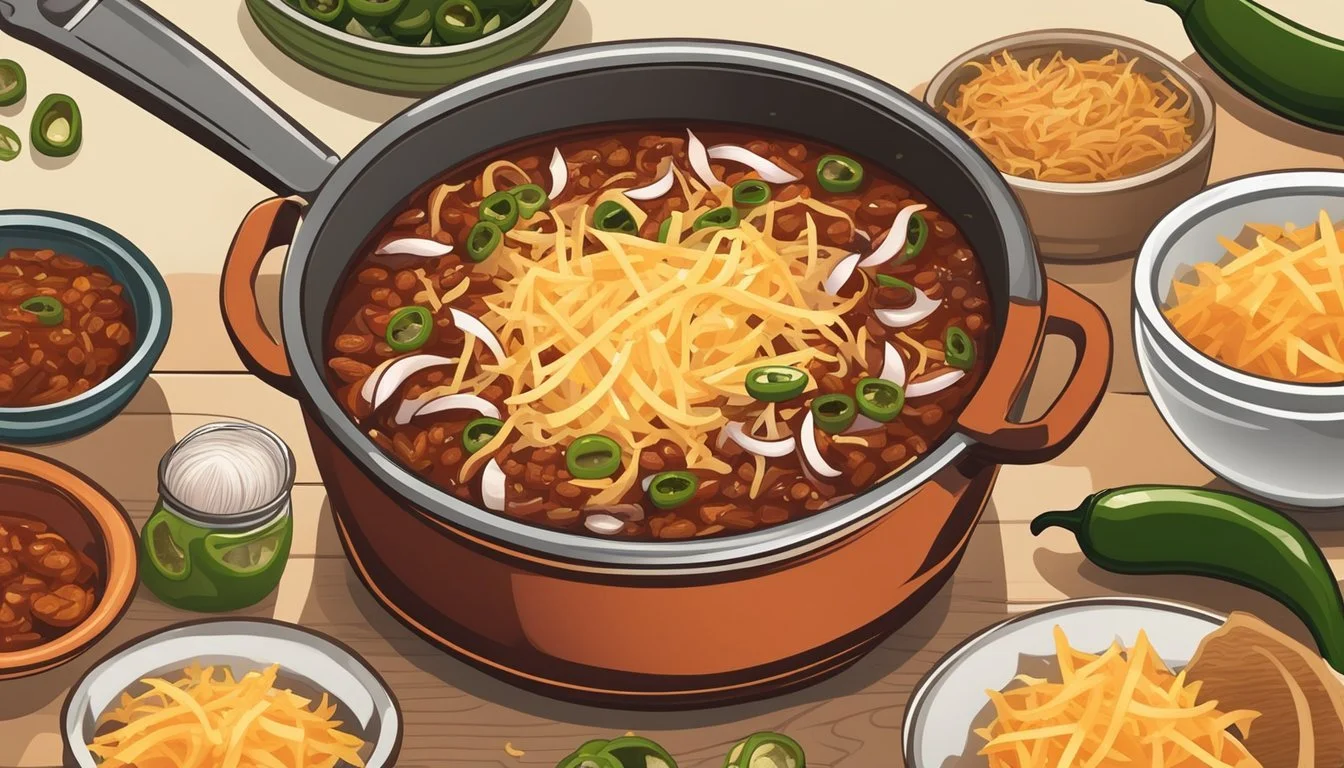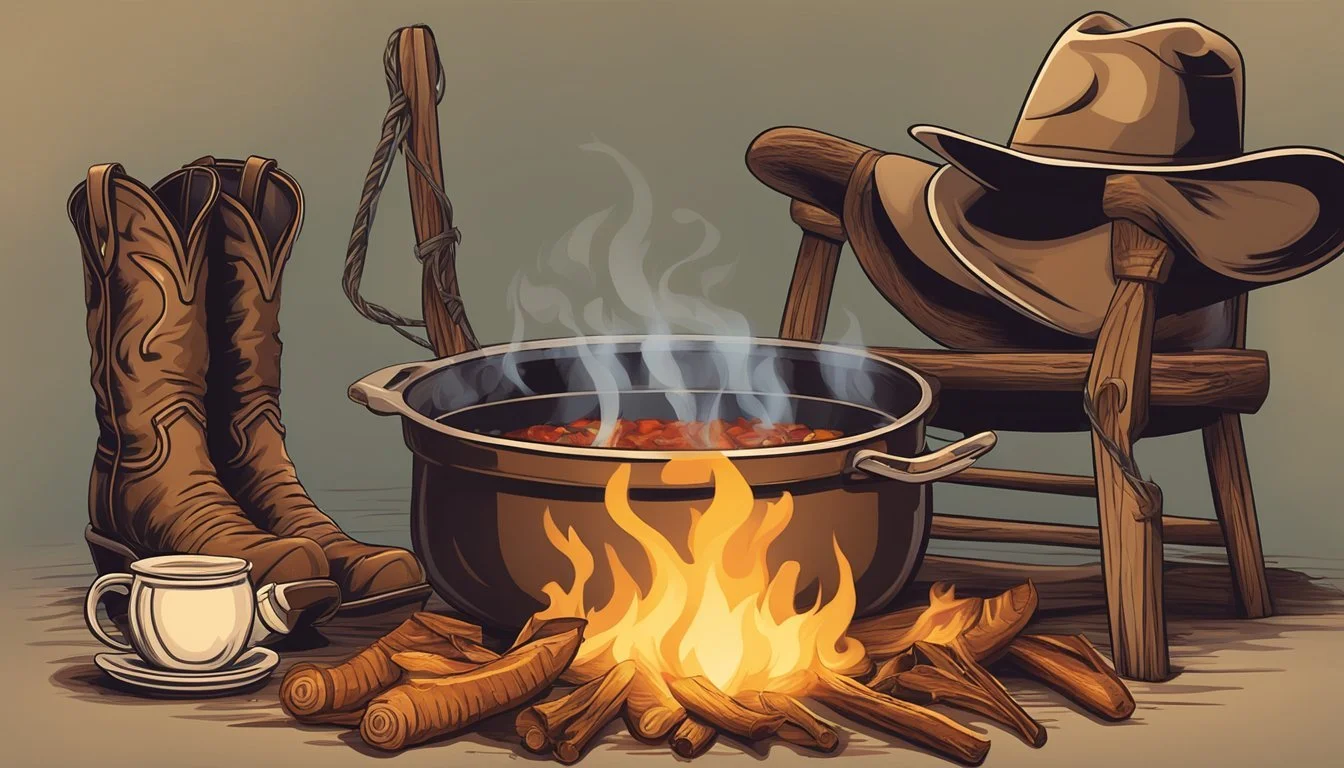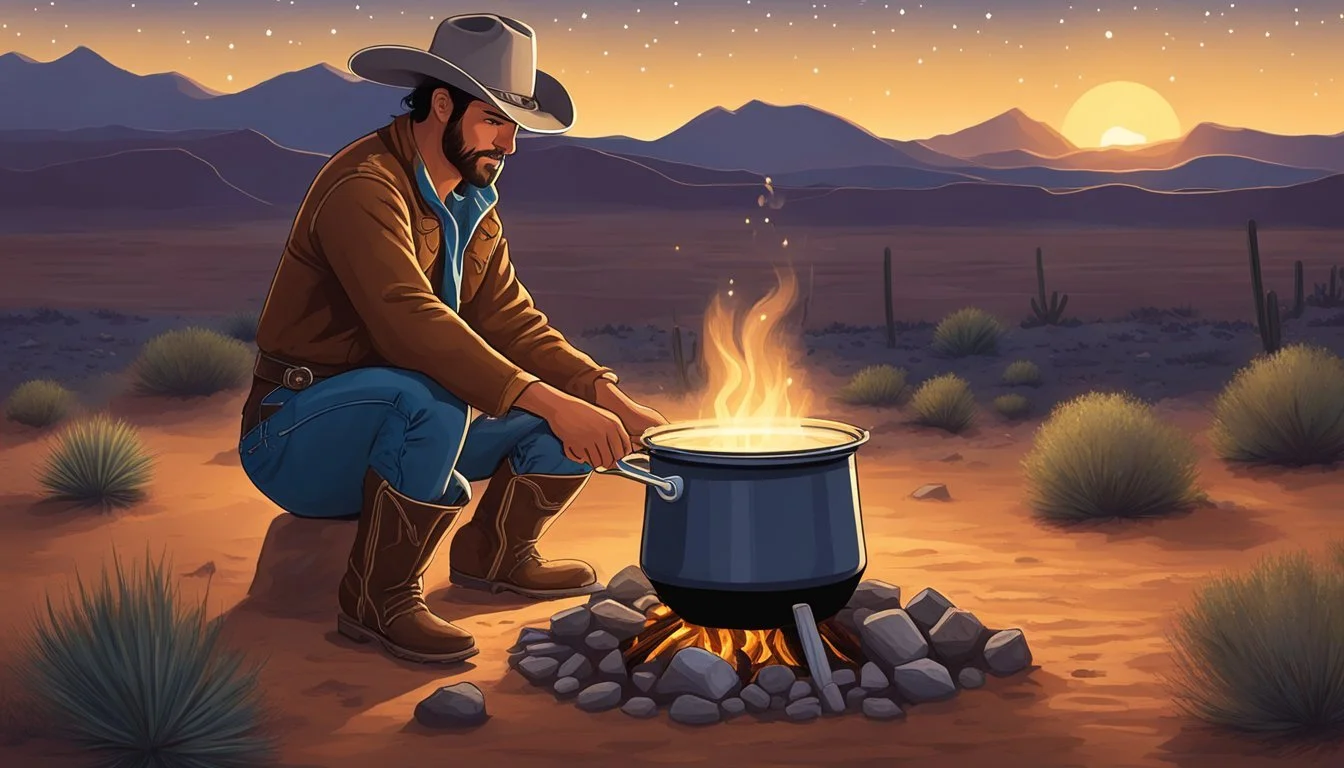The Texas Cowboy's Love for Chili
Unveiling the Tradition's Fiery Passion
The deep-rooted affection Texans, especially cowboys, have for chili is as enduring as their legacy in the Lone Star State. Chili, a robust and hearty dish, has been a staple in Texas for generations, evolving into a culinary symbol of Texan identity and pride. The connection between cowboys and chili is intrinsic; the dish served as a practical, nourishing meal that could be prepared over a campfire during long cattle drives, reinforcing its reputation as a cowboy's sustenance.
With its bold flavors and spicy undertones, Texas chili has come to represent the rugged individualism and tenacity of the cowboys who popularized it. Unlike other regions that incorporate beans or a variety of meats into their recipes, traditional Texas chili, often called 'Texas Red,' is a purist's delight, focusing on the unadulterated flavor of chili peppers and beef, cooked to perfection. Each bowl is a testament to the uncompromising approach that these cattle herders have towards life and food—a no-frills, no-nonsense meal that delivers warmth and satisfaction.
As a tradition, chili has not just remained within the realms of chuck wagons and ranch houses; it has permeated Texan culture at large. This love for chili manifests in community-centric chili cook-offs that dot the state, where recipes boasting a rich concoction of spices and tender beef compete for the top prize, showcasing the enduring bond between Texans and their cherished dish. The cowboy's love for chili is more than a preference—it's a cultural heritage that continues to spice up the culinary landscape of Texas.
Historical Roots of Cowboy Chili
The origins of cowboy chili trace back to the rugged cattle drives across the Lone Star State, becoming a quintessential part of Texan heritage. This spicy stew epitomizes cowboy sustenance and has evolved into a tradition deeply embedded in Texas culture.
Evolution of Chili in Texan Culture
Texans have embraced chili since the mid-1800s, when it began as a simple, hearty meal for cowboys on long cattle drives. Preparing chili allowed them to make use of readily available ingredients while out on the trail. Dried beef, chili peppers, and spices were transformed into a dense, energizing meal that could feed a large group with minimal resources.
The recipe for what is now known as cowboy chili solidified as cooks began to favor beef, a staple of Texas cattle drives, avoiding ingredients like beans that were commonly found in other variations. These early versions of Texas chili were straightforward, comprising primarily meat and heat. As it was easy to prepare, required few provisions, and could be cooked in a single pot over an open flame, chili swiftly became engrained in Texan culinary tradition.
The Significance of Chili to Texan Cowboys
Chili was more than just a meal to the Texan cowboys; it was a source of comfort and a symbol of the cowboy's resourcefulness. The absence of beans in their chili was a notable distinction that signified authenticity in the eyes of many Texans. To them, the lone star state was not only about cowboy boots and the open range but also about the delectable, spicy bowl of red that represented their resilience and camaraderie.
This cowboy chili had to be substantial to sustain the hard-working cowboys throughout the day. The tradition of eating chili continued long after the cattle drives ended, sealing its status as an iconic Texas dish. Its reputation remained robust, from cowboy camps to the creation of "chili parlors" that sprung up across Texas by the turn of the century.
Ingredients of Traditional Texas Chili
Traditional Texas chili stands out for its emphasis on meat and a distinct blend of seasonings, with no beans in the mix. This bold dish relies heavily on select cuts of meat and robust spices that deliver its signature flavor.
Common Meats Used in Chili Recipes
In Texas chili, beef is the most commonly used meat, showcasing cuts like chuck or brisket that are well-suited for slow cooking. Some recipes might also incorporate other meats such as pork or venison (What wine goes well with venison?), but they are less common. The key is to use meats that can withstand long cooking times and contribute to the chili’s hearty texture.
Beef: Chuck, brisket
Other Meats: Pork shoulder, venison
Vegetables and Spices in Texan Chili
While the focus might be on the meat, the blend of vegetables and spices is crucial to Texas chili’s authentic taste. Fresh onions (What wine goes well with onions?) and garlic form the foundation of the flavor, often browned alongside the meat. Chili peppers, including jalapeños, plus a generous dose of cumin, are essential to achieving the dish’s signature heat and complexity. Although some variations exist, tomatoes are typically included to add a touch of acidity and richness.
Vegetables:
Onions (e.g., 2 cups chopped)
Garlic (e.g., minced)
Spices:
Cumin
Chili Powder
Peppers:
Chili peppers (e.g., ancho, pasilla, or other dried peppers)
Jalapeños (seeded and finely chopped)
Preparing the Ideal Bowl of Texas Chili
Crafting the ideal bowl of Texas chili involves a balance of slow cooking techniques and the careful selection of robust cookware to seal in the flavors and tenderness of the ingredients.
Cooking Techniques for Maximum Flavor
To achieve the maximum flavor that characterizes a great Texas chili, one must employ slow cooking methods. The process often begins with browning the meat—typically beef—preferably in a skillet to develop a caramelized crust, which enriches the overall taste. After removing the browned meat, onions and garlic are sauted in the same pan, ensuring that the flavors meld. Key spices such as chili powder and cumin are then stirred in, allowing their flavors to bloom.
Ingredient Technique Duration Meat Brown in skillet Varied Onions Sauté until softened 3-5 minutes Garlic Sauté with onions Add with onions Spices Stir in and cook briefly 1-2 minutes
Following the spices, one deglazes the skillet with a liquid—water or broth—and brings the mixture to a boil. Next, it is transferred to a slow cooker or covered in a dutch oven to simmer for an extended period, often 3-4 hours. Occasional stirring is crucial to ensure that the chili cooks evenly and that the flavors are well integrated.
Selecting the Right Cookware
The choice of cookware is a pivotal factor in the success of Texas chili. The ideal vessels for chili-making are a large pot, dutch oven, or slow cooker. These tools excel in slow-cooked dishes due to their heavy construction and even heat distribution, which is essential for bringing out the flavor of the chili without burning it.
Large Pot: Suitable for initial sautéing and browning on the stove top, and can be used for the whole cooking process if it’s heavy-bottomed.
Dutch Oven: Cast iron dutch ovens retain heat well and are perfect for moving from stove top to oven, if necessary.
Slow Cooker: Offers a set-it-and-forget-it convenience, maintaining a steady low temperature that tenderizes the meat over several hours.
Each option ensures that the heat is distributed steadily and slowly, allowing the chili to cook gently while the flavors concentrate and the meat becomes tender. Choosing the correct cookware and slow cooking techniques are key to creating an ideal bowl of Texas chili that is both flavorful and deeply comforting.
The Role of Spices and Seasoning
The intricate blend of spices and seasonings is fundamental to Texas chili, creating a flavor profile beloved by cowboy tradition. They balance heat with nuanced taste, ensuring each spoonful has the right kick.
Building a Rich and Complex Flavor Profile
Chili connoisseurs know that spices are the building blocks of a flavorful Texas chili. Cumin, a staple in this dish, imparts a warm, earthy note while chili powder and chile powder contribute a variety of flavors depending on the types of chilis used, with some blends offering a more smoky undertone. Paprika, especially when smoked, adds further complexity to the dish, and cayenne pepper introduces a subtle, fiery heat.
Spices Used in Texas Chili:
Cumin: Earthy base flavor
Chili powder: Mild to moderate heat
Paprika: Sweet or smoky notes
Cayenne pepper: Sharp, spicy accent
Balancing Heat and Flavor
Achieving the right balance between heat and savoriness is crucial in Texas chili. It’s not just about the boldness of the spice but also the depth of flavor. Oregano offers an aromatic touch, combining well with cumin for a rounded taste. Jalapeño peppers, when added, bring a bright, piquant quality. This balance ensures the chili satisfies those seeking heat while also captivating those after a rich array of flavors.
Balancing Agents:
Oregano: Aromatic, subtle sweetness
Jalapeño: Bright, sharp heat
Careful adjustment of spices and heat levels can create a well-rounded chili that caters to various palates.
Variations of Chili and Personalization Tips
Texas chili is a dynamic dish that can be tailored to meat-lovers and vegetarians alike. The traditional recipe's adaptability allows for a range of proteins and a spectrum of flavors to suit any palate.
Incorporating Different Meats and Proteins
For meat enthusiasts, the choice of protein significantly influences the chili's flavor profile. Here's a breakdown of popular meat options:
Chicken: Lighter than red meat, chicken adds a delicate texture, suitable for those seeking a healthier version.
Ground Beef: The quintessential choice for classic chili, offering a rich, satisfying taste.
Ground Turkey: A lean alternative to beef, imparting a lighter flavor while maintaining the dish's hearty quality.
Venison: For a gamey twist, venison brings a distinct, bold taste often favored in traditional Texas recipes.
Preparation tips:
Brown meats before simmering to deepen flavor.
Cut meats uniformly to ensure even cooking.
Vegetarian and Vegan Options
For those who prefer plant-based variations, the trick lies in substituting meats with hearty alternatives while maintaining the robust chili essence:
Beans: Kidney, black, and pinto beans are frequent stand-ins, offering protein and texture, despite traditional Texas chili recipes typically forgoing them.
Personalization tips:
Mash some beans for a thicker, creamier base without meat.
Experiment with tofu or tempeh for added protein that absorbs the chili flavors well.
Accompaniments and Toppings
When it comes to Texas chili, the dish's robust and hearty flavors are often complemented by a variety of sides and toppings that enhance its richness and textural complexity.
Traditional Sides to Pair with Chili
A slice of cornbread provides a sweet and soft contrast to chili's spiciness. This traditional accompaniment is best served warm, often with a dollop of butter melting into its golden crust. Another common side is white rice, which acts as a neutral base, absorbing the chili's flavors and providing a balance to its intensity.
Creative Toppings for Enhanced Texture
Chili aficionados appreciate the addition of toppings that not only impart contrasting flavors but also introduce different textures to the dish. Here are suggested toppings presented in a clear format:
Shredded Cheese: A handful of shredded cheese such as sharp cheddar melts into the chili, adding a creamy, tangy layer.
Sour Cream: A swirl of sour cream introduces a cooling effect and a creamy texture that pairs well with the heat of the chili.
Crunchy Elements: Crumbled tortilla chips or saltine crackers offer an enjoyable crunch and can absorb some of the chili's excess liquid.
Fresh Toppings: Chopped onions, cilantro, or scallions provide a fresh, aromatic kick that brightens the hearty earthiness of the chili.
Nutritional Aspects of Chili
Chili, particularly the hearty Texas cowboy variety, offers a range of nutritional benefits while also posing some challenges in terms of caloric and fat content. Understanding these aspects can help individuals make informed dietary choices.
Analyzing the Health Benefits
Texas cowboy chili is rich in protein, primarily from the beef used as the key ingredient. This protein is essential for muscle repair and growth. The dish is also a source of fiber if beans are included, aiding digestion and providing a sense of fullness which can help with weight management. The variety of spices typical in chili, such as chili powder and cumin, offer antioxidants that can combat inflammation.
Managing Caloric and Fat Content
A typical serving of Texas cowboy chili provides around 350-450 calories, depending on the ingredients and portion size. The caloric content largely stems from the meat, particularly if cuts with higher marbling are used, and from any added fats like oil or butter. To manage calorie and fat intake, individuals can opt for leaner cuts of beef and moderate the amount of added fats. Using beef broth can add flavor without excessive fat. Here is a brief breakdown of the nutritional content:
Nutrient Content Calories 350-450 calories per serving Protein High (from beef) Fat Varies (higher with marbling and added fats) Fiber Present (if beans are included)
In summary, chili can be a nutritious part of a diet when consumed in moderation and prepared with attention to the fat and caloric content.
The Future of Cowboy Chili
As traditions evolve and culinary practices adapt, the enduring legacy of cowboy chili is set to experience innovative shifts in preparation and recognition.
Innovations in Chili Cooking Techniques
Modern Slow Cooker Adaptations: With the integration of new cooking technologies, the classic cowboy chili recipe is being adapted for the slow cooker. This method not only preserves the bold flavors and simplicity that cowboy chili is known for, but also allows for a longer cooking time, resulting in deeper flavors as the ingredients meld together.
Use of Masa Harina: Often used to thicken Texas red chili, masa harina — a type of corn flour — has found its way into cowboy chili recipes. This traditional ingredient continues to be a game-changer, adding subtle flavor and perfect consistency to the beloved dish.
Chili Competitions and Culinary Recognition
Cookoff Events: Chili competitions are propelling cowboy chili into the spotlight, where chefs and home cooks alike vie for the title of best chili. At these events, the recipes focus on honoring the traditional components while showcasing individual innovation. Each cookoff serves as a catalyst for future trends and encourages the preservation of this culinary tradition.
Culinary Artists' Take: Professional chefs are adding cowboy chili to their repertoire, treating it with the same respect as any gourmet dish. They are experimenting with locally sourced ingredients and reinventing the classic with a contemporary twist, bringing new life to the Texas staple and solidifying its status in the culinary world.








